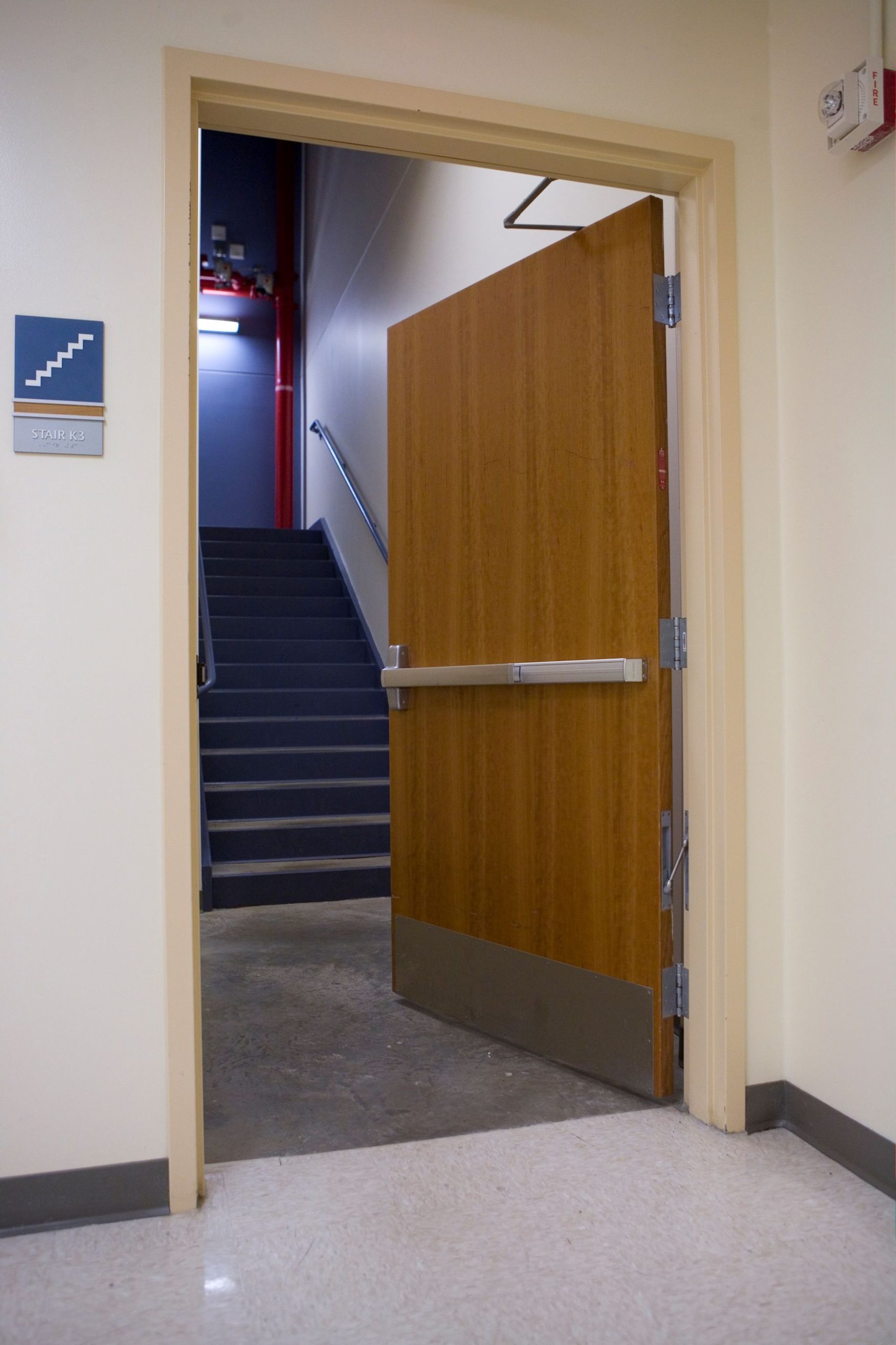 On behalf of an iDigHardware reader, I need help from someone with a really long memory or a better filing system than mine. Or even if you just have a theory, I’m willing to do some more research. 🙂
On behalf of an iDigHardware reader, I need help from someone with a really long memory or a better filing system than mine. Or even if you just have a theory, I’m willing to do some more research. 🙂
The question has to do with opening force for fire doors – particularly stairwell doors. Trying to find the balance between pressurized stairwells and the maximum allowable opening force for the stairwell doors has been an ongoing problem. I wrote about it back in 2014, and I still don’t have a good answer.
The maximum opening force for doors allowed by the accessibility standards is 5 pounds, but fire doors and exterior doors are exempt from this requirement in the ADA standards and ICC A117.1. NFPA 80 does not limit the opening force for fire doors, but in Annex A of the standard there is a section reinforcing the importance of sufficient closing force to allow the fire door to latch. This section recommends a door closer with a spring size of 3 or 4, which will require well over 5 pounds of opening force.
The model codes establish an opening force limit of 30 pounds to set a fire door (or exterior door) in motion, and 15 pounds to open the door to the fully-open position; some state and local codes further restrict these forces. Even with the 30lb/15lb allowable forces, there are often problems getting doors swinging into pressurized stairwells to comply. When the air pressure is factored in, the doors often exceed the allowable forces to open.
This prompted a question from a reader:
Where did the limit of 30 pounds to set the door in motion and 15 pounds to open the door fully come from?
This is a really good question. These limits are far beyond the 5-pound limit for accessibility, so these doors would be problematic for some people with disabilities to operate. Were these numbers just randomly selected, or was research done regarding forces that would allow the doors to be operable by the majority of building occupants? I understand the reason for the exclusion of fire doors and exterior doors from the 5-pound limit, but it’s interesting that the codes and standards don’t include a means of providing more closing force while also allowing people with disabilities to use the doors. And with regard to pressurized stairwells, how far into the closing cycle is the 30-pound force allowed? Or if 15 pounds to open the door to the fully-open position is acceptable, why not 16 pounds? Or 20?
I did some research and found that these limits were added to the NFPA codes in the 1985 edition. I don’t have the code change proposal and reason statement from that code development cycle – maybe that would give us a clue about where the limits came from.
The IBC Commentary doesn’t really help:
The ability of all potential users to be physically capable of opening an egress door is a function of the forces required to open the door. The 5-pound (22 N) maximum force for pushing and pulling interior swinging doors without closers that are part of the means of egress inside a building is based on that which has been deemed appropriate for people with a physical limitation due to size, age or disability. The operating force is permitted to be higher for all exterior doors, interior swinging doors that are not part of the means of egress, doors that are part of the means of egress but also serve as opening protectives in fire-resistance-rated walls (i.e., fire doors), sliding doors and folding doors. This recognizes that doors with closers, particularly fire doors, require greater operating forces in order to close fully in an emergency where combustion gases may be exerting pressure on the door assembly. Similarly, exterior doors are exempted because air pressure differentials and strong winds may prevent doors from fully closing automatically. Requirements for power-operated doors are in Section 1010.1.4.2. The opening force is different than the force to retract bolts or operate other types of door hardware.
A maximum force of 15 pounds (67 N) is required for operating the latching mechanism. Once unlatched, a maximum force of 30 pounds (133 N) is applied to the latch side of the leaf to start the door in motion by overcoming its stationary inertia. Once in motion, it must not take more than 15 pounds (67 N) of force to keep the door in motion until it reaches its full open position and the required clear width is available. To conform to this requirement on a continual basis, door closers must be adjusted periodically and door fits must also be checked and adjusted where necessary.
So…where did these limits come from? How can we find out? WWYD?
You need to login or register to bookmark/favorite this content.








Maybe came out testing??
https://nvlpubs.nist.gov/nistpubs/Legacy/hb/nbshandbook141.pdf
If you have a contact in UL, that can get you to Dr. Daniel Madrzykowski
Director of Research at UL’s Fire Safety Research Institute
He maybe a source to help you find the answer.
I don’t know the history of the numbers, but my theory for the two numbers is the difference between inertia and momentum. It requires more force to overcome the door’s inertia (standing still) than it does to continue the motion (swinging).
That’s a brain-teaser! I don’t have the historical data, but this situation has always been a conundrum between satisfying the opening force requirements and the closing force needs for fire doors. There was a project where the stair towers, of a large county courthouse, were pressurized and we had to stack two LCN 4000 series door closers to get the ground level fire doors to latch. These ground-level fire doors emptied into the grand lobby. Needless to say, getting into the stairwell required some effort and did not meet A117.1 accessibility requirements.
Lori I have an ongoing battle with stack pressure and static air problems . I have in talks with some AHJ’s proposed the installation of a Fire rated air transfer grill . This allows a door to close during normal operation
Thanks David –
Where is the grill installed? In the door or somewhere else?
– Lori
That is an interesting idea. I have recently had an issue in a high rise at the pressurized stairwells and the rated mechanical rooms.
It seems that there’s at least some research and experimentation being done internationally with the use of air curtains for smoke and hot gas control at openings — perhaps that might be part of the answer to this conundrum?
Lori, I have a question regarding a front door to a restroom with multiple stalls. The restroom door has a push plate on the outside and a pull plate and handle on the inside. The customer wants it to be able to be locked, when maintenance is being done, but he still wants to keep the push and pull plates. These is a building with 17 floors with 2 of these type of restrooms on each floor. What can I use and still be code compliance
I would appreciate your help on these issue
Thank you
Hi Ulisis –
Typically, the type of lock that would be used in this application is a classroom function deadbolt. It would allow the door to be locked with a key from the outside. The inside thumbturn retracts the bolt but will not project it. If you need to be able to lock the door from the inside (for example, for a worker to go in and then lock the door), there is a special function that has a cylinder on the inside that will throw the bolt, and a thumbturn to retract it. There is more info about this special function here: https://idighardware.com/2014/07/wwyd-school-multi-stall-bathrooms/.
– Lori
When I read the question, my first guess was from The American Society of Heating, Refrigerating and Air Conditioning Engineers (ASHRAE). ASHRAE has focused on all things providing the comfort and ventilation systems of buildings since its founding in 1895. Their ASHRAE 2019 Handbook HVAC Applications has an entire Chapter 54, that details much about the engineering of pressurized fire and smoke control systems, of which doors play an important part. Section 9 of Chapter 54 shows a detailed equation of the door force parameters as well as a worked Example 3. The parameters include the force to overcome the door closer and friction forces, door width, door area, pressure difference across the door in inches of water and offset of the point of application of the forces.
“Example 3. For a side-hinged swinging door 3 feet wide by 7 feet high with a door closer that requires 9 pounds of force, with a pressure difference of 0.35 inches of water, the door opening force is applied at a lever handle such that the offset is 3 inches, the calculated door opening force is 30 pounds force.”
The text mentions that no sticking parameter is included, probably because doors should not stick, and this would be difficult to evaluate beside.
There are two studies by ASHRAE that developed experimental criteria for setting a standard of 30 pounds to overcome the inertia and pressure and the standard 15 pounds to maintain the opening action. Once the door has opened, the pressure differential is rapidly reduced, effectively 0 when the door reaches 90 degrees. In the course of trying to answer the question you posed, I found some comments that the opening force parameters were in line with children or weak individuals being able to meet the exert but none of these quoted a source of study. The ASHRAE experimental criteria are probably in ASHRAE Project RP-1203 and/or RP-1447. I do not have those in my library. I will see what the Internet turns up, It always fun trying to answer questions
I was surprised by the opening force provided by the door calculation.
Thanks Jerry!
– Lori
I found the following concerning a study of people in wheelchairs and using walkers, probably close to the lower limit of forces required.
Pubmed.ncbi.nlm.nih.cov 2016;229:612-4
Abstract
“Users of walkers and users of different categories of wheelchairs tested doors with different opening force, aiming to reveal the limit that these groups of people could manage on an everyday basis. 94.7% of the wheelchair users reported that a door opening force of 30 N was acceptable, while as 92.1% of this group described 40 N as acceptable. Similarly, 100% of the walker users reported that a door opening force of 30 N was acceptable, while as 87,5% of this group described 40 N as acceptable.”
Some conversions
22.2 N = 5#
30 N = 6.7#
40 N = 8.9#
130 N = 29.2#
I would guess whoever set the original door opening force parameters would probably have approached the task by examining what was possible for we humans. I found that most people can push with a 200#, 1,000 N force. I think you would probably have to be well braced standing at a doorway to exert this much forward force. Champion weightlifters can bench press about 700 pounds, 1000 Newtons but that force is all away from them, no movement of the body. I found that over a range of strengths, women are stronger than a number of men. All this probably does not help the cause of answering the question. To me it shows the complexity of what seem to be simple problems. In my experience, i occasionally end up in an air handling unit with static pressures around 5 Inches wg. The fans were started by my staff from the motor control center with me inside. By this method, I found a wall supporting the fan system between ther discharge and suction side of the fan was moving about 12 inches under pressure, dragging the brace bolts shot into the floor with it. The bolts had been sheared off at the floor but were sitting as if in perfect condition in the brace. ! Sometimes I wanted out before my staff wanted me out. So, I discovered that mass times velocity, thrown suddenly at the compartment door would cause it to open enough that the air pressure force against the door was reduced enough for me to open it further. So, add to the other complications, that of the inertia of the person opening the door can be included. I had lots of inertia, not because of my velocity either.
Wow! This is great information! Thanks so much, Jerry!
– Lori